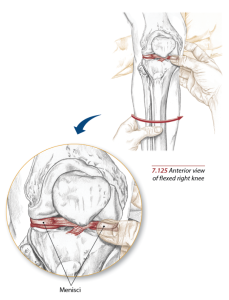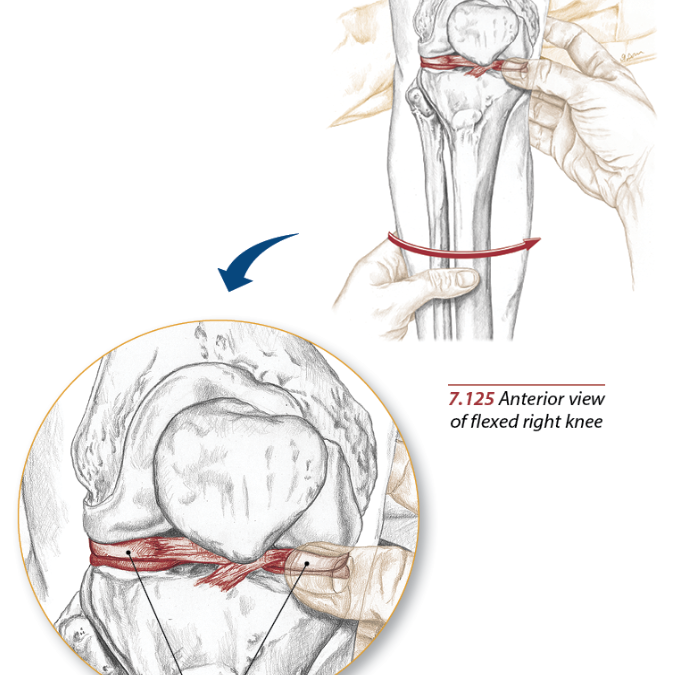As a fitness trainer or coach, you will undoubtedly have to create an exercise program around aching knees for many of your clients because a large percent of the world’s population has or will have a knee problem.
Here are some of the most common injuries that affect the majority of the population; whether stemming from lack of conditioning, overtraining or simply a bad move.
What does the meniscus do?
The menisci literally get caught between the knee bones during exercise and sports movements and sometimes torn when twisted too far. Knowing about these structures helps you choose biomechanically appropriate exercises for clients and keep them safe while moving on your watch.
The menisci are two, ‘C’-shaped hybrid types of cartilage that act as the shock absorption system of the knee. The menisci help distribute stresses over a broad area of articular cartilage, absorb shock during dynamic loading, and help with joint lubrication.

2014 Books of Discovery
Unlike articular cartilage which is predominantly composed of Type 2 collagen in the organic matrix, menisci tissue is made up of the same coarse Type 1 collagen organic matrix found in tendons and ligaments, giving the meniscus the great tensile stiffness it exhibits.
Without the menisci, the daily stress of walking and the compounded effect of running, jumping, and weightlifting would be impossible. The menisci offer the additional protection to the articular cartilage covering the ends of the femur and tibia while simultaneously aiding in the lubrication of all the internal components of the knee.
What causes a meniscus tear?
A torn meniscus is generally caused by one of two things; acute trauma or degeneration of the knee joint. Acute trauma is the type of injury caused by physical activity in which the knee is subjected to constant forceful blows. This is common in activities such as football, rugby, baseball, soccer, basketball and racquet sports.
Other types of acute trauma injuries are also common in activities of daily living. For example, if the knee is rotated forcefully while the foot is firmly planted on the floor while bearing weight, the meniscus can become injured.
Other causes for a meniscus tear are Hyperflexion or Hyperextension, which can happen during a car accident or other low impact activities if the knee is unstable. The most common mechanism of injury is non-contact stress from deceleration or acceleration coupled with a change in direction (cutting maneuver).
Joint Degeneration (Osteoarthritis), or wear and tear, is the most common form of arthritis, affecting at least 20 million people worldwide. Sparing no race, age or gender, Osteoarthritis sets in when the cartilage that covers the ends of the femur, tibia, fibula, and patella deteriorates over time. Eventually, when the cartilage breaks down you are left with bone rubbing on bone, which is usually accompanied by an overgrowth of bone (osteophytes). This in turn narrows the joint space and places even higher compressive forces on the meniscus, leading to a tear.
Types of Meniscus Tears
Meniscus tears are classified by how they look as well as where the tear occurs.
Longitudinal Tears are the most common variety usually occurring at the back or the inner cartilage and are common in young adults during sports activities. The injured person can generally pinpoint the incident with three factors being present. The knee was flexed while bearing weight and then twisted.
Bucket Handle Tears are tears around the rim of the meniscus causing the central portion to displace into the joint. It is commonly referred to as an exaggerated form of a longitudinal tear where a portion of the meniscus detaches from the tibia, forming a flap that looks like a bucket handle.
Flap Tears have a loose medial flap along a horizontal plane that tends to flick over from time to time causing symptoms. They can occur as an acute tear or as a progression from longitudinal tears.
Transverse Tears also referred to as radial tears can be small where only a portion of the meniscus is torn generally radiating from the inside to the outer menisci or large where the tear reaches almost to the outer portion.
Torn Horn Tears also referred to as Parrot Tears, are commonly found in the posterior horn (tip) of the meniscus, specifically the posterior inner aspect that’s more toward the center of the knee joint. A forceful blow or twist such as pivoting during physical activity is the most common cause for a Horn Tear.
Common Symptoms of Meniscus Injuries
A meniscus injury can make itself known in various ways. Sometimes the injured person experiences a “popping” sensation during an athletic event. It is important to note though that while tears are more commonly seen in athletes or those with demanding occupations where the knee is constantly at risk, they can also occur with seemingly innocuous activities such as jogging or squatting.
There is usually significant pain along the joint on the side of the injury while some tear patterns will cause a portion of the torn menisci to be trapped between the joint causing the knee to lock where extension and flexion are impossible.
The following are common signs of meniscus injury:
- Pain
- Swelling
- Inability to fully extend or flex the knee without discomfort
- Locking or catching of the knee
- Weakness of the quadriceps evident when walking up or down stairs
- Continued popping, locking or buckling
Meniscus injuries are common and important to know about so you that you program knee exercises accordingly and communicate with your clients health practitioner.
References
1. Collado H., Fredericson M., Patellofemoral pain syndrome. Clin Sports Med. 2010:29:379-398
2. De Cardo M, Armstrong B. Rehabilitation of the knee following sports injury. Clin Sports Med. 2010:29:81-106
3. Steiner T., Parker RD., Patella subluxation and dislocation. DeLee and Dree’s Orthopaedic Sports Medicine 3rd ed.
4. Clark, J. M. (1990). “The organization of collagen fibrils in the superficial zones of articular cartilage.” J Anat 171: 117-30.
5. Mechanics of human joints” Physiology, Pathophysiology, and treatment. Unsworth, A. 1993
6. Basic Orthopaedic Biomechanics, Second Edition, Van C. Mow, Wilson C. Haynes, 1997
7. Medial Collateral Ligament Tears, Cedars-Sinai, 2012, a 501(c)(3)
8. Arthroscopic repair of traumatic longitudinal meniscal tears, K Roeddecker, G.D. Giebel, C. Lohscheidt and M. Nagelschmidt, 1993, Vol 7 Num 1
9. Meniscus tear recovery time, Benjamin Wedro, MD, FACEP, FAAEM, 2012 10. Bursitis, The Basics, What you should know about bursitis, 2012 Carol Eustice, ASCP, ARHP
Beverly Hosford, MA teaches anatomy and body awareness using a skeleton named Andy, balloons, play-doh, ribbons, guided visualizations, and corrective exercises. She is an instructor, author, and a business coach for fitness professionals. Learn how to help your clients sleep better with in Bev's NFPT Sleep Coach Program and dive deeper into anatomy in her NFPT Fundamentals of Anatomy Course.



